![]()
Lundahl LL 1933 MC-trafo - ENGLISH
Manufacturer: Lundahl Transformers, Sweden - .https://www.lundahltransformers.com/moving-coil-input/
Price: LL 1933 - pair 3.400,- DKR including Danish VAT. (460 Euro)
Price; LL 1933 Ag - pair 10,780, DKR including Danish VAT (1,447 Euro)
Latest update 19 October 2020
Swedish “top
class” step up transformers
Lundahl
transformers should be known by most. They build everything from output
transformers (tubeamps) to interstage, line- and powertransformers. In their
program there is also a very large selection of SUTs (step up transformers) to be used between a MC cartridge
and a normal RIAA input. For those who should have forgotten what it's all
about - or who just want to know more about the technology - please take a
closer look here: LINK - THE SUT .
In the following I will also refer to the
Excel spreadsheet that can be downloaded from the above page.
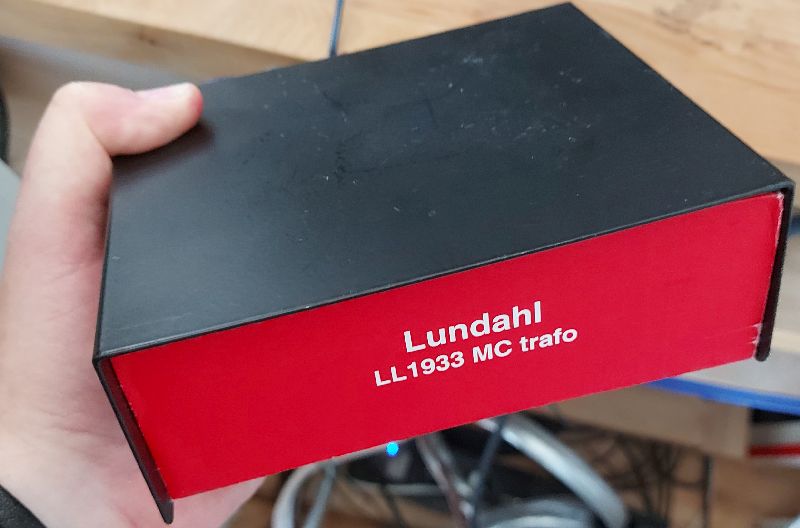 | 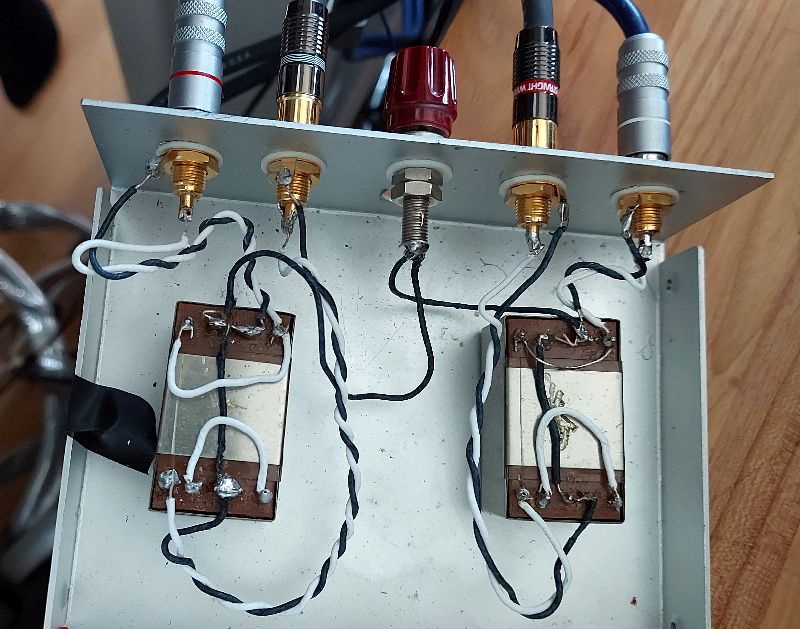 |
Background
and structure
It's been a
while since I invested in two LL 1933 MC transformers. The selection at Lundahl
is large with as many as 10 different versions, so it can be difficult to
decide. There are e.g. also LL 1941, which offers a step up ratio of 1:18 and
1:32. The latter suitable for super low output MC pickups from e.g. Audio Note,
Lyra and Ortofon. Four of the transformers are also available in an
"Ag" version - ie with silver wire internally.
Lundahl
LL
1933 is with mu-metal (nickel) core and the corresponding LL 1931 with
an amorpheus cobalt core. Whether one is better than the other, I
should not be able to say, but there are differences. Lundahl describes
LL 1933 as "A SUT for those who
prefer a low distortion, and linear magnetic curve from a nickel
laminate
core" It should sound a little warmer and more pleasing, where the
amorpheus cobalt core in 1931 is a bit smoother and a little more
revealing. Furthermore, they
write that the double coil construction (which is common to the almost
all
their MC transformers) improves the immunity to magnetic fields from
power
supplies, motors, etc. Internally, conductors of Cardas OFC copper are
used.
The transformer itself is mounted in a mu-metal housing. Both LL 1931
and 1933
are also available in versions with silverwindings. Here the price is a
little
more than 3 times higher. Whether the use of silver changes the sound,
I cannot
say, but in Thomas Meyer's blog VinylSavor:
http://vinylsavor.blogspot.com/2011/12/lundahl-silver-mc-transformer-listening.html)
he says, that the difference when using silver in transformers is far
greater
than what one experiences in cables. Maybe I should invest in a set of
silver
Lundahls, to experience the difference?
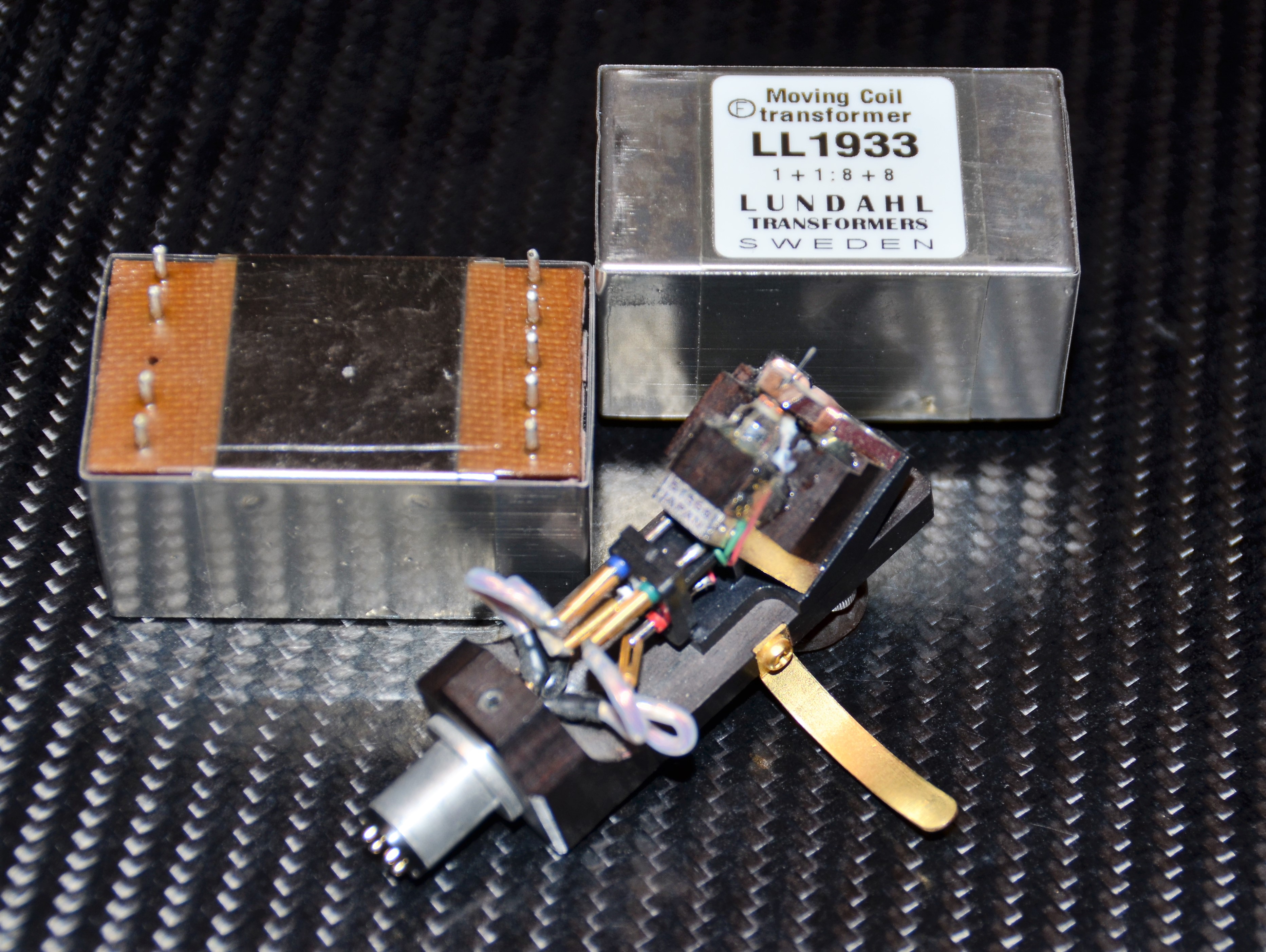 | 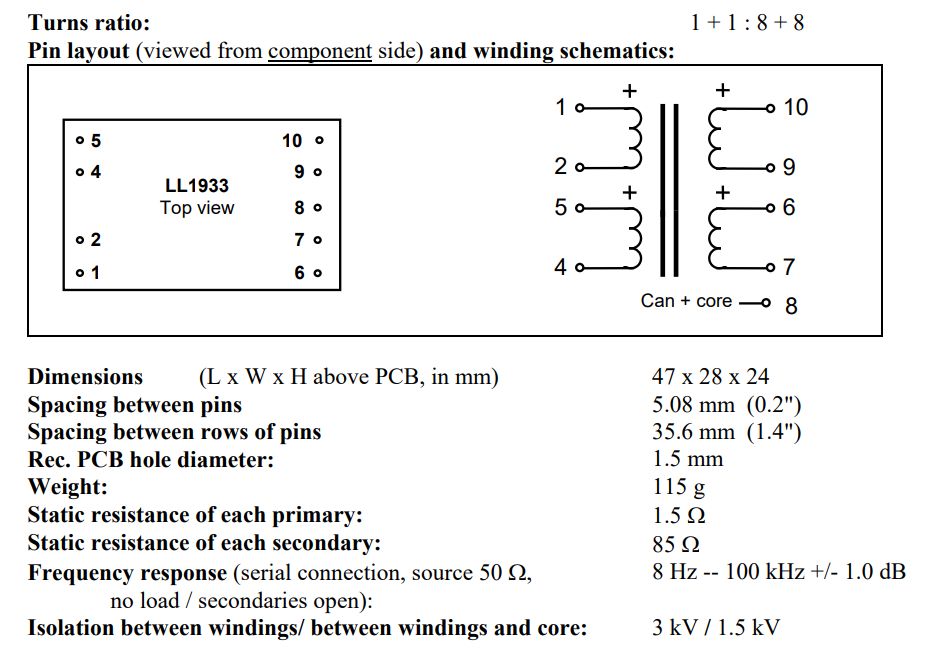 |
As
mentioned, I have had the two LL 1933 lying around for a few years. The connection
of the terminals gave me a disproportionate number of problems. It does not
help that Lundahl writes "connections seen from the component side"
in their instruction. Which side? Should I flip it all over or should I look at
the side where the terminals are? After many attempts and lots of hum, I almost
gave up. But with more searching on various forums and a more targeted
approach, the problem was solved. And yes, the drawings are seen from the
terminal side - so it is quite simple!
I connected
my transformers in the configuration parallel / serial, which gives a ratio of
1:18. In other words, a gain of 24 dB. It should be suitable for typical
low-impedance MC pickups with approx. 0.2 to 0.5 mV out. It is also possible to
couple the transformer to 1: 8, which gives 18 dB gain. This setting is suitable for cartridges with somewhat
higher output. In the end, it also depends on how much amplification there is
in the connected RIAA, as well as how much output you actually need.
I mounted
the transformers in a small aluminum box with a metal lid (magnetic and
shielding). Not that it makes that big a difference. The transformers
themselves are screened and in addition, the double construction makes it
possible to work fine without additional screening. All internal connections in
the box were made with Silver Sonic solid core silver cable.
Note that
Lundahl in their specs indicates a
source impedance of 50 ohms as well as an open output. I know of no MC
cartridges with such a high source impedance. Many of the newer ones have very
low impedances around the 2-3 ohms, but the normal is probably closer to 6-8
ohms. Whether a typical load of 47 kohm at the output is the same as
"open", one can discuss. Either way, it's impressive data which
shows. that Lundahl knows how to make a good SUT.
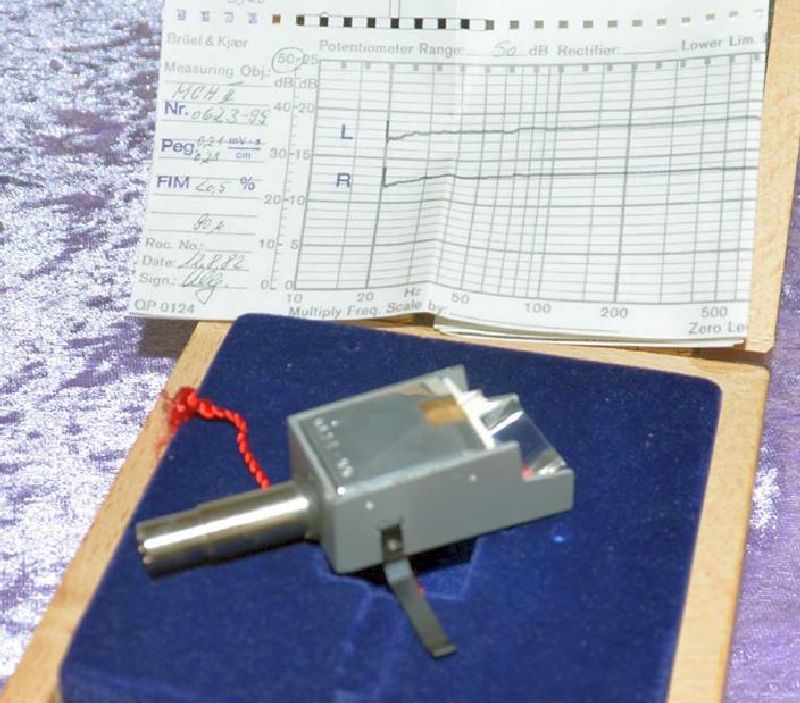 The sound
of the LL 1933 MC transformer
The sound
of the LL 1933 MC transformer
I have
listened to (reviewed) many different step up transformers. The best were the
Ikeda IST-201 with a ratio of 1:20 / 26 dB gain (DKK 29,900) and My Sonic Lab
Stage 1030 (DKK 36,900) also with a turnover of 1:20 and gain at 26 dB. As can
be seen, the prices are something completely different than Lundahl LL 1933,
but whether the sound can be compared to these high end transformers is
something completely different. However, I can say that LL 1933 is absolutely
without hum, buzz or any other disturbing elements. If you have control of your
ground and other connections, everything works flawlessly.
The first cartridge
I tried was an Accuphase AC-3. With an output of only 0.2 mV and an internal
impedance of 4 ohms, it must be said to have been ahead of its time (from
1984). It is more like specs you find in today's top MC’s. The sound is still
excellent - yes with LL 1933 actually more than excellent. It is already a very
dynamic and controlled cartridge, but here there is more body and power. You
can clearly hear that the AC3 is doing well with this transformer coupled to
the normal RIAA input on my Accuphase C-27. There is absolutely no noise and compared
to the MC-input on the C-27, you can say that the sound is more physical and a
bit more alive with a physical punch. There is, as I have experienced it
before, a little more air and black background directly into the C-27, but the
other way around, with the LL 1933 in the signal path it helps to make the experience
a little more exciting and immediate.
Next cartridge
was my IKEDA 9Gss silver. Again low
output 0.28 mv and an output impedance of approx. 2.8 ohms. Yes, it does well
the little Lundahl transformer. However, it lacks just the last air and space
that I know this top cartridge manage. But in the lower octaves there is a good
fullness and control. As I remember Ikeda's own transformer, there was a larger
open window and a nice air to the upper range. But at the same time it also
played differently than the active solution via my Accuphase. At first glance,
I would say that the LL 1933 is probably not intended to be used with a cartridge
in this class, but in terms of gain, they fit well together. The impedances I
will come back to later.
Then I
tried with my Ortofon MC-3000. It is stated to be 0.125 mV out, so it almost
requires a SUT. The output impedance is 6 ohms. Ortofon's own T-3000
transformer indicates a gain of 30 dB, which is 6 dB more than the 24 dB we
achieve with LL 1933. However, I heard clearly. that the resulting output to
the RIAA (approx. 2 mV) is somewhat lower than the other cartridges. In
general, this combination has a somewhat more smooth and relaxed way of playing.
The MC 3000 is still a revealing and smooth cartridge. These qualities are
intact and in general one would probably be able to accept it all as a
successful combination. Was it not because I have heard better with an active
solution or e.g. the T-3000 transformer (with silver coils), then this would be
absolutely acceptable.
Last cartridge
was a Thorens MCH II. In fact, it is sources from EMT. It offers 0.25 mV output
and 22 ohms internal impedance. Here it all fitted like hand in glove! I have never heard this cartridge so dynamic
and immediate with lots of punch and a solid bass. There was an infectious joy
of playing with lots of dynamic range. At the same time the top from the VdH tip
was smooth and detailed. I Played all three records in my "Ella & Lois
/ Classic Album Collection". This was music! I used this combination for a
long time during this review and will probably do so in the future.
Calculations
With the
help of the spreadsheet I linked to in the beginning, you can easily find gain and
impedances with different SUTs.
LL 1933 has
a gain ratio of 1:18. Looking into the typical 47kohm load from the RIAA, it
will provide an input impedance of 184 ohms. A rule of thumb says that the
optimum is a load of 10 times the internal impedance of the cartridge. Some say
it must be 5 times and then again others say something completely different.
For the four cartridges mentioned above, it will then only fit with Thorens MCH
II and its 22 ohms impedance. By changing the RIAA load from 47K to 100K, the
input impedance increases to 391 ohms. This was also tried and gave a little
more air and details with this cartridge.
But why was
the result with the Accuphase AC-3 positive? With the 4 ohm output impedance,
it looks into the same 184 ohms. It is far higher than the immediately optimal 40
ohms. With a SUT it is possible to load the output with a parallel resistor
(good low inductance quality). With 13k we get the approx. 40 ohms, which
should fit better..
Likewise my
Ikeda should have a load around 30 ohms - ie a load resistance of approx. 9k.
Strangely enough, Ikeda's own transformer IST-201 results in a load of 118
ohms, so the “rule” with 10 times the internal impedance should probably be
taken with a pinch of salt. Or has Ikeda loaded the transformer internally,
without telling anyone about it?
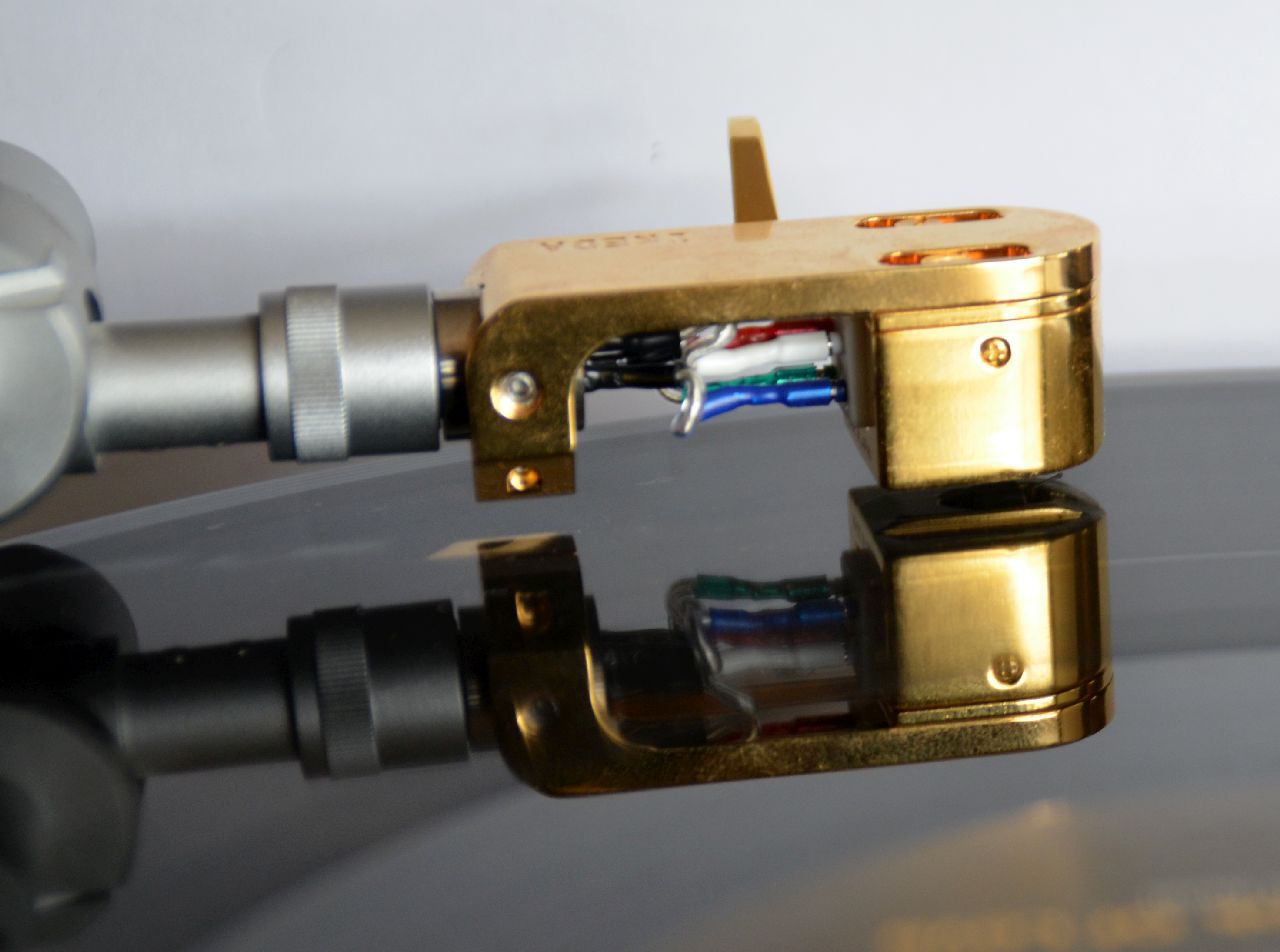
Conclusion
Lundahl LL 1933 delivers a very convincing reproduction. As Per Lundahl himself writes, "Where other companies stop, we start". You could say they believe in themselves and their products. Regardless of the qualities of the transformer, it must match the cartridge you want to use. In the four cases I tried here, it was my Accuphase AC-3 and even more so Thorens MCH II that gave the best results. The latter was almost a kind of symbiosis with LL 1933, so the result was super musical and with lots of presence, warmth and generally a naturally relaxing reproduction. I have heard better transformers with my IKEDA 9Gss and Ortofon’s MC 3000. The latter was immediately a little too reluctant with the LL 1933. In both cases I would think that other MC transformers from Lundahl will do better. Could be tempting to try the silver version LL 1933 Ag or maybe LL 1931 Ag. There is silver coils in my IKEDA, so there might be a good chance that silver in the SUT is what I need?
October 2020 - Lundahl LL
1933Ag - silver version
Late Septenber
2020 the two LL 1933 Ag arrived from Sweden. I immediately noticed that the silver version is a finer product.
Instead of a cardboard box, the silver SUTs are packed in a nice wooden box
with a magnetic lock. The two SUTs have a
black label, but otherwise they are in the same dimensions and with the same connections as
the copper version. At first they came into use, using RCA connectors that just hang in the cables bouncing. They
worked - nice music came through them!
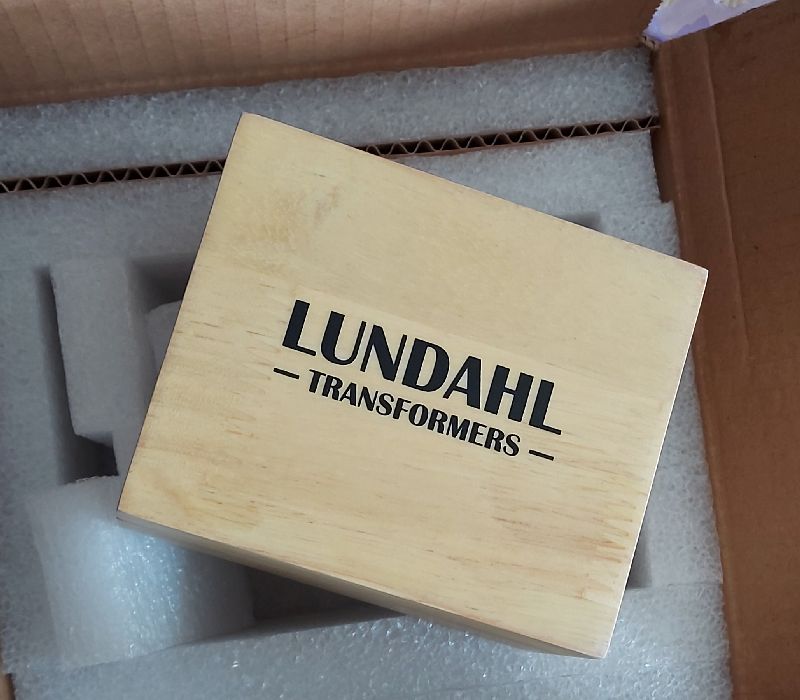 | 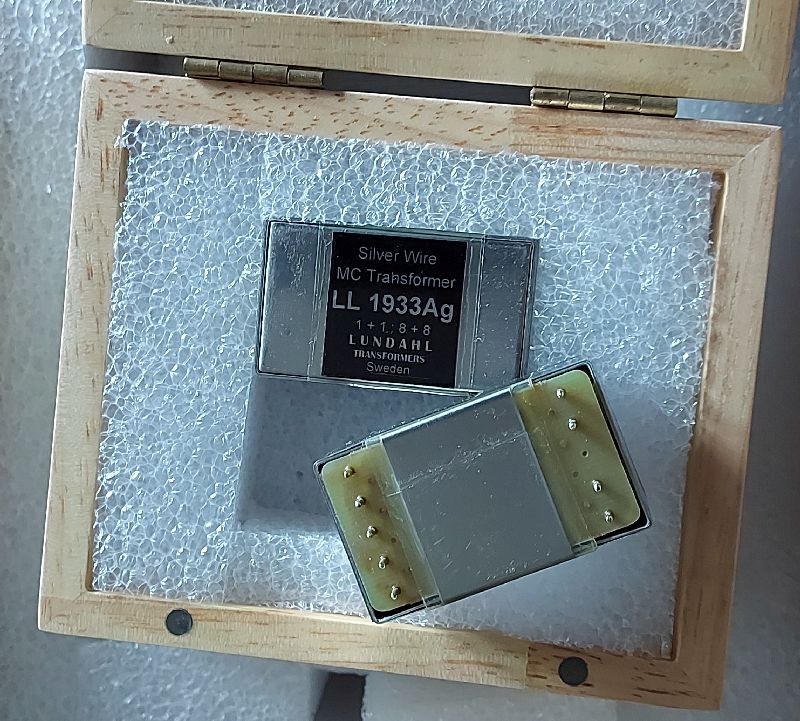 |
A stable frame was made using 2 mm solid copper. Later a solid wood frame will be added to what will become the top of the cabinet. But they play now - no hum and all as it should be. As the pictures show, the SUTs were again connected using the Silversonic solid core silver cable. The connectors are rhodium-coated RCAs from Cardas. I think you have to do it well,w hen you invest a nice amount in a product like this.
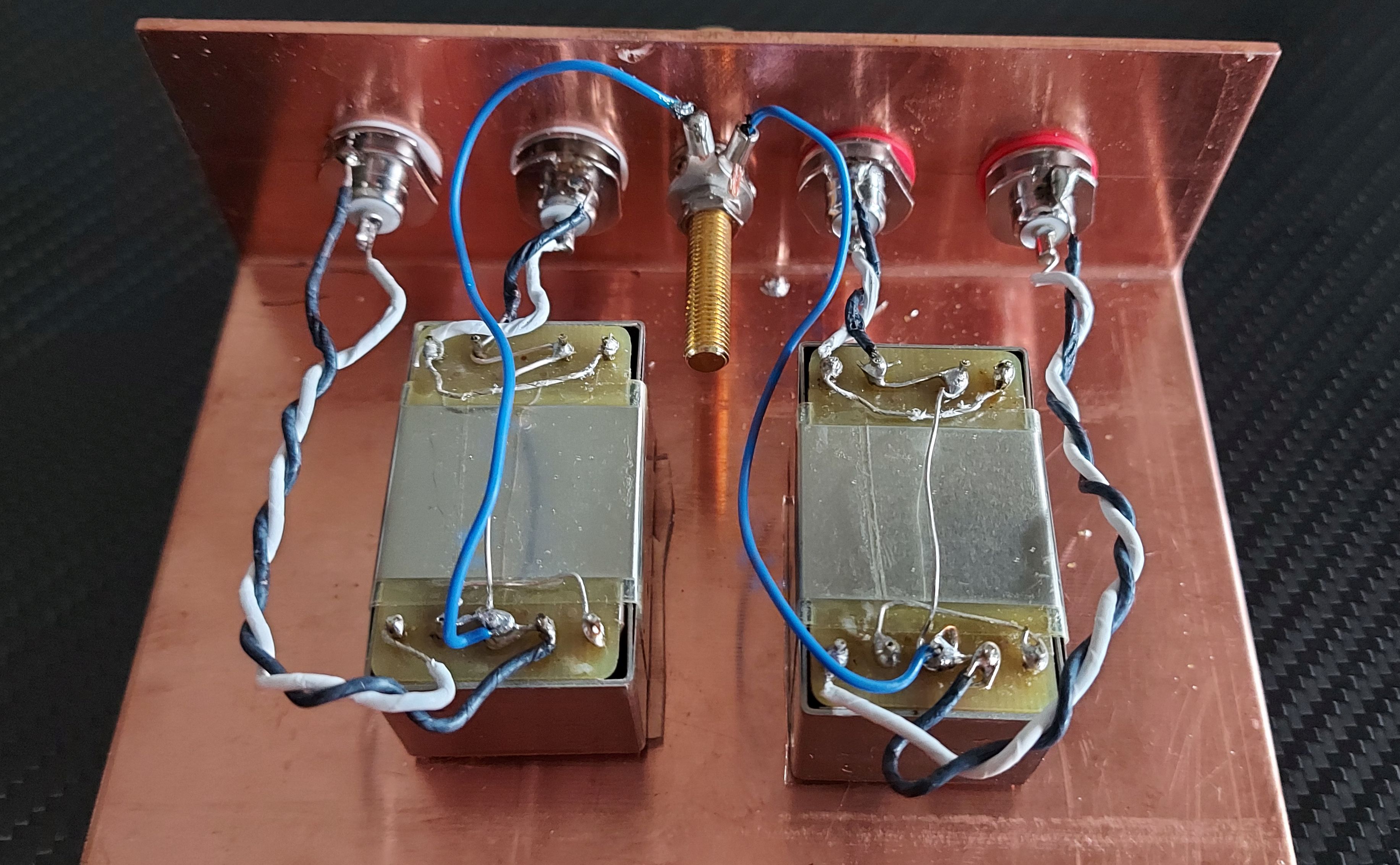 | 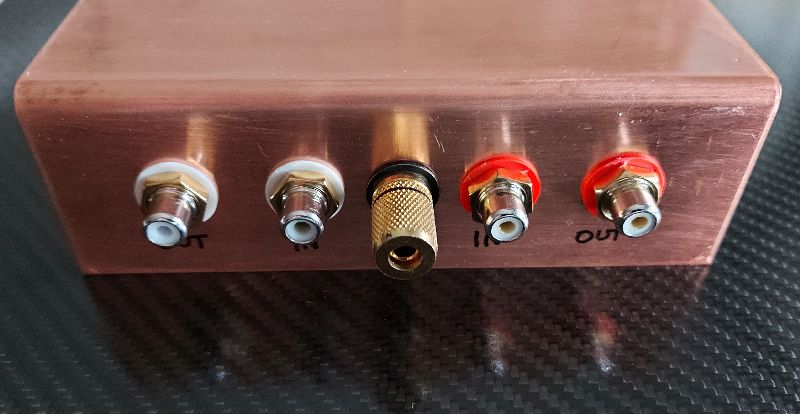 |
The sound of LL 1933Ag
My biggest
curiosity was whether there really was a sonic difference compared to the
regular copper version of LL1933? Yes, there is! It is not great, because as
with much other high-end hifi you only get small improvements for the last
invested money. The law of diminishing returns.
The first
thing I noticed was something unexpected, a little more weight and solidity.
There is just a bit more authority and power in the silver SUTs. Some say it's
a hallmark of nickel in the core. It's there in the copper version too, but
here we have that special bodily representation - even more than the one I fell for in the copper SUTs.
Many talk about "silver sound" in cables - meaning a
slight focus on the top octaves and a bit of extra artificial details. There were none of these trends here.
But what
about the rest? I mainly used the Hana ML and my Ikeda cartridge. Gain is as with
the copper version quite satisfactory with 24 dB, which works fine in my setup.
This provides 6.2 mV from Hana ML and 4.1 mV from my Ikeda 9Gss respectively.
One of my often
played records is Bo Sundström / "Mit Dumma Jag". Someone may know him
from Bo Casper's Orchestra, but here it is subtle and humorous Swedish jazz. On
top of that, the LP is well recorded. I noticed an extra layer of
overtones and air. Details in the top octaves that came better to its right, but at the same
time were a part of the musical experience. The last month or so I have used
the Hana ML via the LL 1933 copper version. It was absolutely audible that through the LL 1933Ag the sound
just opened up with more details
in the
upper range. More air and a somewhat larger and more open soundstage.
The
LL1933Ag manages to show what this excellent cartridge can do.
Using the Ikeda cartridge, I also found it quite obvious that
there was more space
and room for the musicians. Everything feels a bit more obvious and
free with a
better look into the musical experience.
With Inger
Marie Gundersen / Feels Like Home on the recordplayer, I switched between the
two SUTs using the Ikeda cartridge and
the
same volume setting. Still, it was as if there was a bit less gain on
"Long as I Can See the Light" through the Ag version. A few shifts
back and forth revealed the difference. Via the Ag SUT, her voice moved
a few
steps back into the space behind the speakers. At the same time,
there were more details and
a somewhat different “total” experience. The window into the music
became larger
and more coherent. I could now better recognize the qualities I know
there are
in my Ikeda 9Gss. The next step will be to find the correct RCA cable
from SUT to RIAA (I used the Cardas Clear) and then just get the tube
RIAA finished
I've just started building
Conclusion
With
Lundahl LL 1933Ag I have a SUT that meets my requirements for the best
of my cartridges.
It is a better SUT than the copper verison LL1933. Whether it
is on par with the best in the world is a question. If it is the
right one for you I can not tell. What do you
prefer and which cartridge will it be used with? I am certainly
satisfied with
the LL 1933Ag. With my Ikeda as signal source I have found a worthy
partner. In short – I´m excited about the result and enjoy the music.
BACK TO THE
FRONT PAGE - in Danish